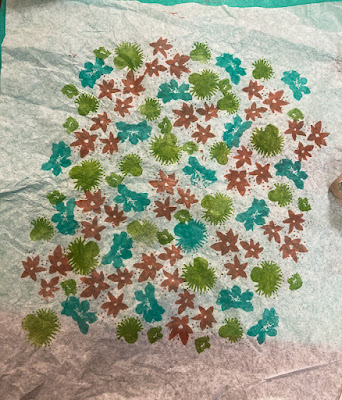There are ever so many wonderful old stamping techniques out there that I, as well as lots of others I'm sure, tend to forget about. But they are so good that we just have to do our best to keep them alive and thriving.
One of those techniques is that of "kissing". I know it sounds really romantic, but it's really not. It's just a great way to add some wonderful texture to a stamped image that might otherwise have little to no personality.
In my card today, that's how I did the pot in which the cactus grows.
The pot would otherwise have been just a plain solid stamped pot. But, a little kissing added lots of unexpected personality to it.
You can see in the images below how different each of the pots are. That's part of the beauty of kissing, the unpredictability.
To do kissing, ink up a solid stamp with a color that you want your base color to be. Take a dry -- uninked -- stamp with some line work, as you can see in the rubber stamp in the lower right of the photo. Place the uninked stamp onto the base inked stamp and give it a little twist. Not too much. Too much twisting can remove more of the detail than you'd like.Then lift the uninked stamp straight up. And your pot is finished!! The kissing is complete.
Once my pot was kissed, I fussy cut it and glued it to a piece of cardstock that I was going to use as my focal point. Next step was to plant the cactus inside the pot.
Other than the layers of cardstock, this is basically a one-layer card, not much dimension at all, except for the cactus layer popped up with Stampin' Dimensionals on the DSP layer.
Here's a tutorial on how to make a card similar to this one.
SUPPLIES:
White cardstock
Soft Succulent cardstock
Recycled light-colored cardstock
Designer Series Paper
Forever Fern stamp set (retiring)
Cactus Cuties stamp set (retired)
Melon Mambo ink
Soft Succulent ink
Gray Granite ink
Die Cutting/Embossing Machine
Deckled Recctangle Dies (page 163 in the new Annual Catalog)
Stampin' Dimensionals
INSTRUCTIONS:
Fold a 5 1/2" x 8 1/2" piece of white cardstock in half, creasing it well with a bone folder.
To this card base, add a 4" x 5 1/4" piece of Designer Series Paper that will coordinate with the rest of the card elements.
Set this aside for now while we work on the focal point area.
Using the Deckled Rectangle Dies, die cut from Soft Succulent cardstock a 3" x 4 1/4" rectangle, and from a light-colored neutral cardstock, using the same dies, cut a 2 5/8" x 4" rectangle. Adhere these two together.
On white cardsdtock, in Soft Suffuculent ink, stamp the two pieces of the lined cactus. In Melon Mango ink, stamp the flower. Fussy cut these components, leaving a fine white margin.
On white cardstock, you will be stamping your pot using the kissing technique. Ink up the pot image with Gray Granite ink. Take a clean stamp with lines of interest on it (I used a flower stamp) and place the stamp to the inked pot and give it a quick twist. Stamp the kissed stamp onto white cardstock. This will provide an interesting textured look to the pot. Fussy cut the pot.
On the layered rectangles, lay out your pot and cactus, and, once satisfied, glue the cactus in place and add the pot with a couple Stampin' Dimensionals.
Adhere this completed focal point to the card.
^^^^^^^^^^^^^^^^^^^^^^^^
Close your eyes and I’ll kiss you,
Tomorrow I’ll miss you.
- Paul McCartney -
^^^^^^^^^^^^^^^^^^^^^
Kissed
Smiles.























































